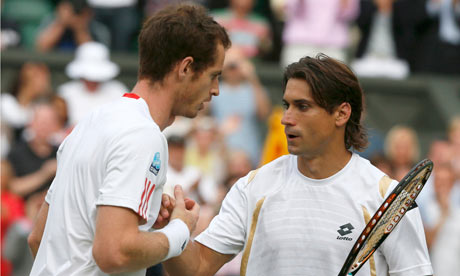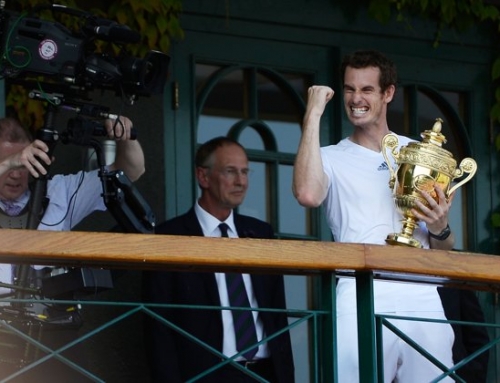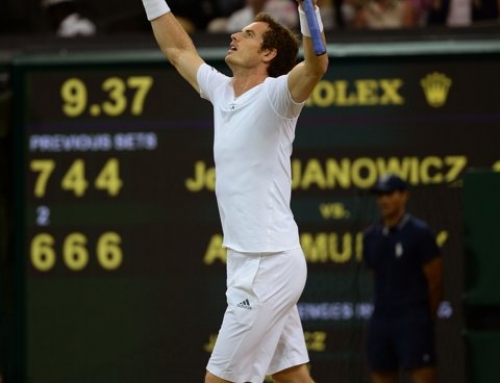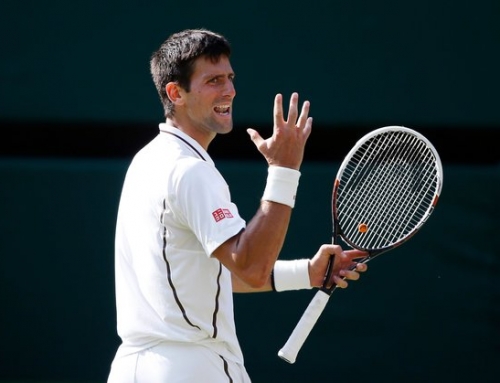 When the Wimbledon draw came out about two weeks ago, fans had to be thinking, oh no, not again. Roger Federer was once again put in the same half of the draw as Novak Djokovic, a trend that seems to defy statistical odds. And that meant, once again, Andy Murray was put in the same half as Rafael Nadal. Since this pairing has happened in numerous Slams, Murray’s path would, once again, run through Nadal. Andy Murray would tell you that Rafa is the only top player he’s beaten in the Slams. He’s lost to Roger twice (in the Australian Open finals and the US Open finals). He lost to Djokovic earlier this year. Indeed, because Roger and Novak have been paired so often, Murray almost never plays Djokovic in a Slam because it would have required upsetting both Rafa and Roger in the same tournament by both players (not one of them upsetting both).
When the Wimbledon draw came out about two weeks ago, fans had to be thinking, oh no, not again. Roger Federer was once again put in the same half of the draw as Novak Djokovic, a trend that seems to defy statistical odds. And that meant, once again, Andy Murray was put in the same half as Rafael Nadal. Since this pairing has happened in numerous Slams, Murray’s path would, once again, run through Nadal. Andy Murray would tell you that Rafa is the only top player he’s beaten in the Slams. He’s lost to Roger twice (in the Australian Open finals and the US Open finals). He lost to Djokovic earlier this year. Indeed, because Roger and Novak have been paired so often, Murray almost never plays Djokovic in a Slam because it would have required upsetting both Rafa and Roger in the same tournament by both players (not one of them upsetting both).
Rafa had been having, as usual, a blisteringly good summer. Despite the Australian Open, his season truly starts at Monte Carlo, and he hopes to ride that to a win at Wimbledon. On clay, he finally beat Djokovic. Djokovic could blame his loss on the loss of his grandfather, but by the French Open, he seemed over that emotionally, even if his game, good as it was, wasn’t ready for a confident Rafa. Ironically, the rain, which made the clay even slower and heavier actually favored Djokovic. He was probably the only one that wanted enough rain to play but not enough to have the match suspended. Alas, it was suspended, and so, under better conditions and better mental circumstances, Rafa came back and won another French Open.
But, you never know.
Most players that play Rafa understand you must overpower him to win. Some players, like Tsonga or Soderling or Berdych, tend to attack him as a matter of style. Some, like Murray, have to add aggression to their games. Lukas Rosol certainly had the kind of power that could bother top players. And Rafa, yes, was making all sorts of errors early in the match to allow Rosol a few free points and to make him nervous about his hitting. If your strokes aren’t going in like they normally do, either you just keep hitting hoping your punches will begin to land, or you play more conservatively, and get more shots in. In any case, Rosol had a Happy Gilmore moment (an Adam Sandler movie about a hockey player with a powerful slapshot, but anger management issues, that switches to golf) where his wild power suddenly flowed, and everything landed in.
So, in theory, Rafa can be beat that way. Hit as hard as you can, and everything lands in. But, can anyone do it time and again. When the next generation of superstars comes around, maybe such a player will be the new number 1.
And with Rafa out of Wimbledon, the entire bottom half of the draw smiled. In particular, Andy Murray. Andy Murray would tell you that Rafa’s loss didn’t open up the draw, at least, not until he reached the semis. It was great for someone like Kohlschreiber who got to play Rosol instead of Rafa and knocked his fantasy trip right out of the tournament, but Murray still had to play the same players he would have if Rafa had still been in the tournament.
But, back to Murray later on.
Roger Federer.
The last two years, Federer has had a roadblock in the quarterfinals. Normally, he doesn’t mind playing someone like Berdych or Tsonga, but one of Fed’s weaknesses is return of serve. He returns serve just fine, but he never tops the statistical list of best returners. On grass, against the biggest servers, Fed puts a lot fewer returns into play than, say, Novak Djokovic, and that means fewer opportunities to break. Indeed, in the classic 2009 final, Federer had to rely on tiebreaks and his ability to hold his own service to beat Roddick. Federer had only one break the entire match. Fortunately, it was all he needed.
Last year, pundits noted how unlikely it was for Roger to lose a match to someone after being up two sets to love. However, it was a very plausible situation considering Roger Federer only had one break point against Jo-Wilfried Tsonga.
One.
It’s hard to win Wimbledon if you can’t break serve, and that was the situation Roger found himself.
He had to be thrilled that his draw included no such crazy good, hard hitting player. And as his draw unfolded, he kept playing players that were of his generation. Xavier Malisse, Julien Benneteau, Mikhail Youzhny. Not that this was so easy. Against Benneteau, Roger was less than his best while Benneteau was playing smart tennis. A tense tiebreak won by Roger and cramps by Benneteau lead to the closest match Federer has played the entire tournament. Against Malisse, the match was a lot closer than expected because Federer’s back was giving him issues. Fortunately, guile and Malisse’s inability to deal with a top player pushing the ball before swiping a big topspin backhand meant Roger was controlling a match he should have been losing.
In the quarterfinals, Roger again faced a player of his generation, Mikhail Youzhny. Roger promised that his back issue was something he had dealt with before, that it was nothing to worry about, that it could easily go as it had come. But Roger also talks about winning Slams even when there are some niggling injuries. Roger talks confident, but is it reality? He’s often been less than honest about how things are going.
But this time around, Roger was spot on. He owned this match from start to end. Youzhny just had no answers. He was so desperate, he asked Agassi, who was sitting in the royal box, for help. The crowd had a good chuckle and Roger had a good win. In any case, Roger had to be happy not to play someone with a huge forehand and a huge serve, and whenever Roger is relaxed playing someone, he plays a lot better.
At the same time, Novak Djokovic was playing Florian Mayer. Mayer had an early break in the first set. His quirky style has him hitting slices and coming to net or using his excessively swoopy forehand to net. But Djokovic got the break back, and while Mayer had chances in a 0-40 game against Djokovic to break again, a volley that was meant to go behind Djokovic was just enough in reach that he made a solid pass. Djokovic would go on to win that game. Though he would surrender more games than Roger Federer did in his, the 64 61 64 win was still nearly as comfortable as Roger’s 61 62 62 win.
If anyone clearly benefited from Rafa’s loss, it was Philipp Kohlschreiber. He beat Lukas Rosol in third round, then he took out Cinderella story, Brian Baker, who had done quite well to reach the fourth round and finally had an opponent who scouted the resurgent American.
But Tsonga also had to be pretty happy. Kohlschreiber, to be fair, has been playing some good tennis lately which is why he’s reached the quarterfinals, but most would say that Tsonga is just too powerful for the diminutive German. Even so, the match was pretty close. Tsonga took the first set in a tiebreak. Kohlschreiber got a break late on to take the second set. Tsonga took the critical third set tiebreak. With that, Tsonga seemed to have worn down Kohlschreiber, who took the fourth set, 62.
That left the toughest match for last.
Less than a month ago, Andy Murray, who had had a subpar clay season, went in not playing his best. It was nonetheless impressive that he reached the quarterfinals. There, he played the red-hot David Ferrer who had not dropped a set to that point, and against Murray, dropped his first, but only in a tiebreak, then conceded the remaining two sets rather tamely. Murray then lost early to Nicolas Mahut in Queen’s, and it was once again, not so sure that Murray was playing good tennis heading into Wimbledon.
On top of that, he was given a very difficult draw, and while the players that were in his draw were far from playing their best tennis, one can never tell whether they will, on any given day, play really well.
One thing, almost no announcers have mentioned, is how Murray has chosen to play Wimbledon. When Murray first came on the tour, he was a quirky player. Today, players like Dolgopolov or Tomic are compared to Murray. But, as Murray had trouble trying to beat players like Nadal and Federer and was repeatedly hounded to be more aggressive, he stopped slicing his backhand so much, stopped hitting as many drop shots. Instead, he played a more straight-forward game, coming over nearly every backhand, not trying to put balls up in the middle inviting the inside-out attack to his backhand where he’d be forced to rush over and slice a ball back.
That had to rankle. Murray likes playing those change of pace, dinkum shots. It’s too bad Rafa is so immune to nearly every finesse style of play. Otherwise, it could have left to some very entertaining matches.
Murray’s run at Wimbledon this year seems to be a big middle finger to his critics. He knows grass takes spin pretty well. So, Murray was going to go back to the way he likes to play. Slice the backhand. Hit the drop shot. And, yes, alternate that with some power shots that he’s picked up the last few years. Murray appears to spin his forehand a bit more these days, especially when he hits down the line.
Still, Ferrer was no easy opponent. If you ask most players about Ferrer, they think he’s a defensive player that counterpunches all day long. That’s not really true. In this modern day and age, you can’t play like Wozniacki or Jankovic or, to a lesser extent, Aggie Radwanska. It’s even hard to play like Monfils or Simon who seem to wait such a long time before playing an aggressive shot. A player like Ferrer, who is much shorter than most players, needs to dictate the point in some fashion to win. If you’re supremely athletic like Monfils, you can be defensive and let the other player move you around. Monfils is so quick that he chases down tons of shots, at the detriment of getting injured so often. Ferrer relies on hitting shots close to the sidelines. Like Federer, he likes his inside out, inside in pattern, pushing a player to the backhand corner to open up the inside in forehand corner.
Unlike Federer, Ferrer can’t put that inside out shot away unless it’s on a high deep middle floater. So, he has to play these elongated rallies. He’s resigned himself to the fact that a player of his power and stature has to be accurate, quick, tireless, so he can play long points. Ferrer’s accuracy and speed, and his ability to return big serves, allowed him to knock out Roddick on his favorite surface and del Potro on his not-so-favorite surface.
And, Ferrer defied odds by coming in playing good grass court tennis. The week before Wimbledon, he played Rosmalen Grass Court Championships played in the Netherlands, and won. Ferrer had only dropped one set to the quarterfinals, that to Andy Roddick who started off hot while Ferrer was wayward with his game. By the time Ferrer got his game settled, Roddick was in trouble, and was in bigger trouble when he couldn’t claim the second set, which he lost in a tiebreak.
Murray, for his part, opened up Wimbledon playing Nikolay Davydenko. Grass has never been Davydenko’s best surface, and his game had dropped considerably since he got injured early in 2010 and tried a new racquet. His confidence never quite returned, though he’s occasionally won a tournament since this precipitous decline. Murray dominated this match and opened up with a resounding start.
His next opponent was Ivo Karlovic, the big serving Croatian. Karlovic is a weird player. He serves bigger than Isner. As much as players claim Isner’s serve is better, Karlovic’s seems harder to break. Karlovic takes advantage of the pressure his opponents feel to hold their serve. He has a powerful forehand and an above average net game. His movement is suspect, and his backhand is at a level nearly 500 spots worse on the ATP rank. Karlovic can slice on that side, but he relies on a big forehand and an imposing net game to win. If he had ever had a world class backhand, he might have been in the top ten for years. In the meanwhile, Karlovic is simply a test of will. Can you hold your own serve. Can you break at least once or get a few points on return in a tiebreak. Murray passed the test, but in four sets.
In the following round, he had to play someone quite different. Marcos Baghdatis is a fast, powerful hitter, but can be inconsistent with his serve and shots. But he can be inconsistent. At his best, he’s reached Slam semis and finals and upset Roger Federer, but injuries and a lack of reliable weapons makes him a wildcard. Murray struggled a bit against Baghdatis, but with the clock ticking down to an 11 PM curfew, he was gifted a bunch of errors by a compliant Baghdatis and won the match in four sets.
Murray started the match hitting pretty well against Ferrer. However, Ferrer was hitting more consistently at the start and got an early break. At 5-3, Murray found Ferrer ready to serve for the first set. If he won this, it would be too resounding a start to a match. Murray managed to take the break back and tie it at 5-all. The two went into tiebreak. Murray could never quite get ahead in this tiebreak, and Ferrer held to 7-5 to win the tiebreak.
The second set was also a bit grinding, and Murray again found himself a break down after hitting a drop shot on break point that landed a hair wide. Murray had to be despairing some watching his Wimbledon dreams slip. At 5-4 down, Ferrer won the first point on a shot hit a little deep by Murray, one that Ferrer would have punished even had it gone in. But then, something strange happened. No, Murray didn’t hit 4 winners in a row. Ferrer made a series of forehand errors and gave the break right back. This set again went to tiebreak. Murray again fell back 3-0 to start this tiebreak, and had to scramble to get it back to 5-all before taking the tiebreak 8-6.
The third set was pretty even until late in the third when Murray played a good game to break, then held on to take the third set. The fourth set again was pretty even. Murray had a 15-40 shot at breaking and holding easily when a forehand winner attempt landed wide. Ferrer would dig himself out of this hole and hold, and the two would again head into tiebreak. Murray had to be feeling pressure having chances to win an easy fourth set, but finding himself in yet another tiebreak.
This time, Murray had a good start at 2-0, but just as quickly, Ferrer came back to lead 3-2. Murray won both his points to 4-3, then got a minibreak to 5-3. Ferrer got 5-4, then Murray played two big serves to take the tiebreak and the match, and book his semifinal meeting with Jo-Wilfried Tsonga.







![[Wimbledon, QF] Murray scraps out 5-set win over Verdasco to reach semifinals](https://www.essentialtennis.com/wp-content/uploads/2013/07/20130703murray-500x383.jpg)